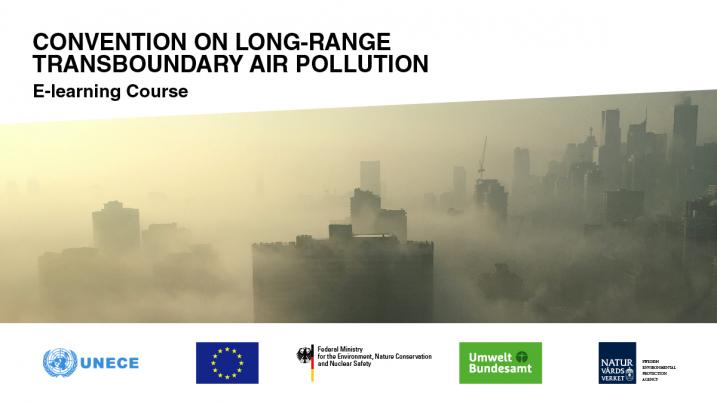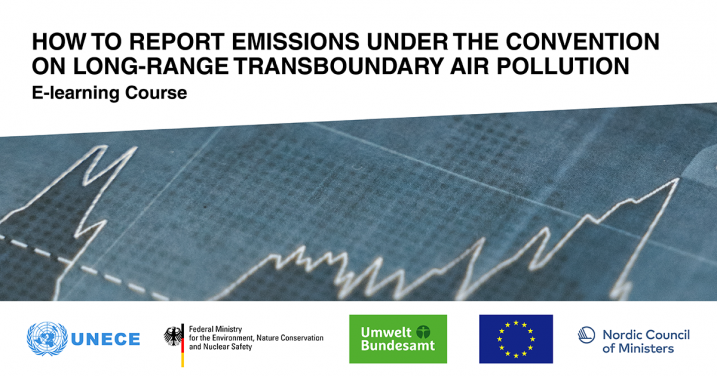
Check out the Convention’s e-learning courses. The course on the UNECE Convention on Long-range Transboundary Air Pollution (Air Convention) and its protocols aims to raise awareness about air pollution and its effects, ways to prevent and reduce harmful emissions, and the Convention and its protocols as an international framework for cooperation on cleaner air. Click here for a direct link to the course in English and Russian. You can also watch the video of the launch event.
The course on emission inventory development under the Convention aims to explain the importance of emission inventories for clean air policy development, the requirements for emission inventory reporting and methods for emission estimation. Click here for a direct link to the course in English and Russian.
The courses are hosted on the UNCC:learn platform, which is managed by the United Nations Institute for Training and Research (UNITAR).
E-learning course on the UNECE Convention on Long-range Transboundary Air Pollution (Air Convention) and its protocols
Air pollution impacts our health, environment and economy. Air pollutants come from multiple sources, such as traffic, industry and agriculture, and are transported over large distances and across borders. It is therefore paramount that we take action together — across sectors and national boundaries.
To improve air quality, UNECE member States have been working successfully since 1979 to reduce air pollution in the region through the Convention on Long-range Transboundary Air Pollution. This cooperation has led to emission reductions, cleaner air, healthier forests and prevented premature deaths.
However, more needs to be done to achieve cleaner air within the UNECE region and beyond. The Convention has engaged in fostering cooperation between regional initiatives around the world and shared the Convention’s experience and lessons learnt with a view to advancing a shared response to addressing air pollution globally.
To assist countries in effectively addressing air pollution and improve air quality management, the new e-learning course aims to raise awareness about air pollution and its effects, ways to prevent and reduce harmful emissions, and the Convention and its protocols as an international framework for cooperation on cleaner air.
Course structure
The course is divided into 4 modules:
• Module 1: The Convention on Long-range Transboundary Air Pollution
• Module 2: The Protocol to Abate Acidification, Eutrophication and Ground-Level Ozone (Gothenburg Protocol)
• Module 3: The Protocol on Heavy Metals
• Module 4: The Protocol on Persistent Organic Pollutants
What will you learn?
After completing the course, learners will be able to:
• Identify key air pollutants and their sources and effects
• Recall measures to reduce and prevent air pollution
• Recognize the value of the Convention as a framework for international cooperation to reduce air pollution
• Define basic principles under the Convention and its protocols
• Explain the basic obligations under the Convention’s protocols
• Identify the key stakeholders and processes under the Convention and its protocols
A basic obligation under the Convention is to report emission inventories. An emission inventory quantifies air pollutants and/or greenhouse gases emitted into the atmosphere in a defined geographical area and time span. Inventories are used to study trends in major air pollution sources and evaluate the impact of air pollution abatement measures. For example, Governments can use emission data to develop sustainable national and local policies, evaluate their effectiveness and impact on populations and ecosystems, demonstrate compliance with emission reduction targets, and provide information to the public.
To assist countries in effectively addressing air pollution and developing emission inventories, this course aims to explain the importance of emission inventories for clean air policy development, the requirements for emission inventory reporting and methods for emission estimation.

Course structure
The course is divided into 3 modules:
• Module 1: Purpose and scope of emission inventories
• Module 2: Reporting process and templates
• Module 3: Emission estimation methods
What will you learn?
After completing the course, learners will be able to:
• Explain what an emission inventory is
• Identify substances that are released into the atmosphere from various human activities
• Describe how emission inventories contribute to the development of clean air policy at national and international levels
• Outline the objectives, scope and principles of the Guidelines for reporting developed under the Convention
• List different source categories covered by reporting obligations
• Outline the principles of completing the reporting templates
• Describe different emission estimation methods used under the Convention
Who should take these courses?
The course is primarily designed to build capacities of policymakers, government officials, staff from intergovernmental/non-governmental organizations, private sector professionals, students/academia, and other stakeholders.
Will you get a certificate?
At the end of the course, learners can take an assessment to receive a certificate of successful completion.
Acknowledgements
The project was carried out with funding from Germany, the European Union, the Nordic Council of Ministers and Switzerland.
With regards to funding from Germany: This project was funded by the German Federal Environment Ministry’s Advisory Assistance Programme (AAP) for environmental protection in the countries of Central and Eastern Europe, the Caucasus and Central Asia and other countries neighbouring the European Union. It was supervised by the Federal Environment Ministry and the German Environment Agency (UBA). The responsibility for the content of this course lies with the authors.

